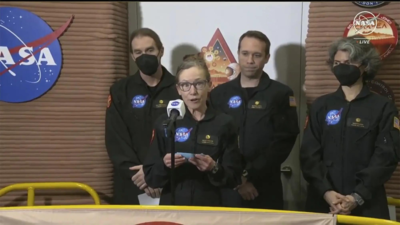- News
- Science News
- One year on 'Mars': What did Nasa learn from CHAPEA Mission 1
One year on 'Mars': What did Nasa learn from CHAPEA Mission 1
Kelly Haston, a 53-year-old biologist, completed a year-long NASA simulation called CHAPEA Mission 1 in Texas to study the impact of isolation on health and performance for future Mars missions. The crew, cut off from the outside world, conducted simulated Marswalks and grew crops. Haston reflected that separation from loved ones was the most challenging aspect.

This is crucial, as a round-trip to Mars could easily take more than two years, including the six-to-nine-month transit time and the duration NASA hopes to spend on the planet.
Haston and her crew were cut off from the outside world, conducting mock "Marswalks," tending to a vertical garden, and occasionally dealing with boredom. She despite the challenges, expressed pride in contributing to space exploration, although the experience made her reconsider the reality of life on Mars.
For Haston, the most difficult aspect was the separation from loved ones. "I could have been in that habitat for another year and survived with all of the other restrictions, but your people -- you miss your people so much," said Haston.
Communication with the outside world was limited, with a twenty-minute delay each way to simulate the time it takes for a radio signal to travel between Earth and Mars. There were also restrictions on sending and receiving videos to account for bandwidth limitations.
Haston found the worst feeling to be when relatives or friends were going through difficult times, as "You couldn't be there for them in real time."
Her only direct human contacts were her three teammates, but she maintains that they never went stir-crazy, despite occasional "crabby days" or individual issues.
"The communication was extremely good in this group. Up until the very end, we ate meals together," " she said.
The NASA Johnson Space Center in Houston housed a 1,700-square-foot (160-square-meter) 3D-printed habitat called "Mars Dune Alpha" inside a hangar which featured crew quarters, common areas, and even a space for growing crops like tomatoes and peppers.
In an exterior area nicknamed the "sandbox," simulated "Marswalks" were conducted. The Martian environment was recreated with red soil and cliffs painted along the walls. Crew members put on spacesuits and passed through an airlock to reach the area, with tasks coordinated by their colleagues inside.
The Canadian crew member, now residing in California, admits there were days when she wished to be outside, but surprisingly, these feelings only intensified towards the end of the mission.
Boredom is an inevitable part of long space expeditions, and the extended isolation set CHAPEA apart from most prior "analog" missions. She spent time embroidering mission symbols and images of Mars to To combat it.
Of course, "analogs can't address all problems or all issues of an eventual mission to Mars," said Haston, though the lessons learned will aid in planning.
Each team member's food intake, blood, saliva, and urine samples were meticulously documented, and their sleep habits, physical, and cognitive performance were analyzed.
NASA scientist Grace Douglas emphasized the importance of the food system in human logistics for resource-constrained missions. Determining the minimum necessary provisions to maintain astronauts' health and ensure mission success is critical.
Currently, NASA is keeping the details of the crew's tasks confidential to maintain the element of surprise for the next two iterations of the mission, with CHAPEA 2 scheduled for 2025.
End of Article
FOLLOW US ON SOCIAL MEDIA

